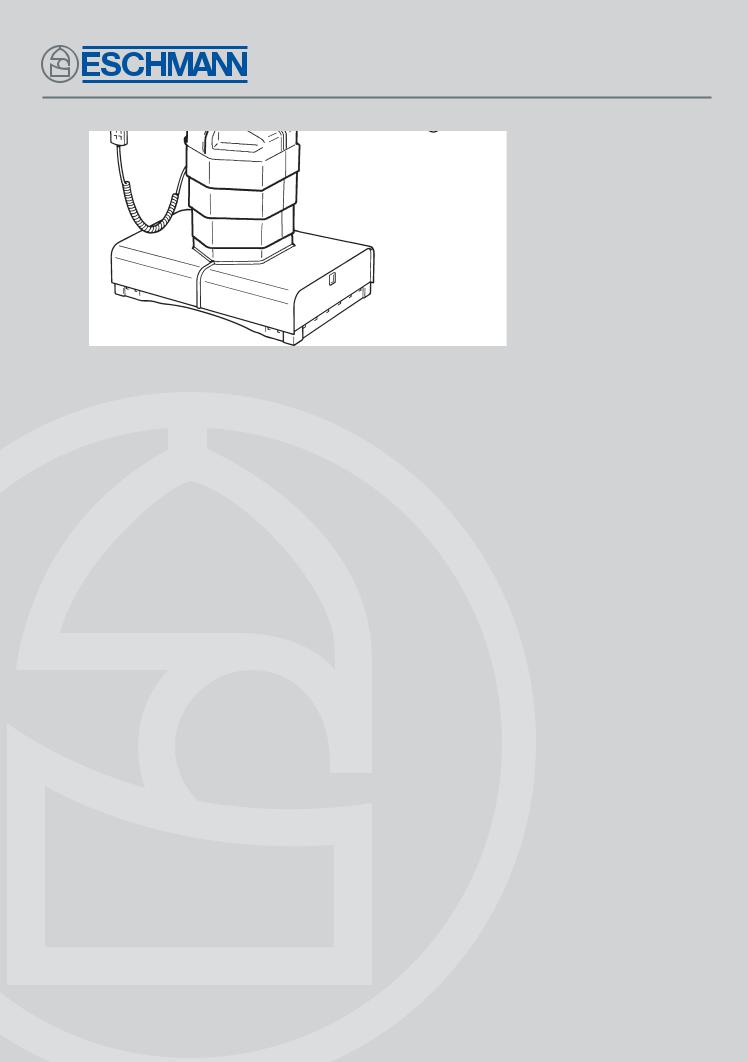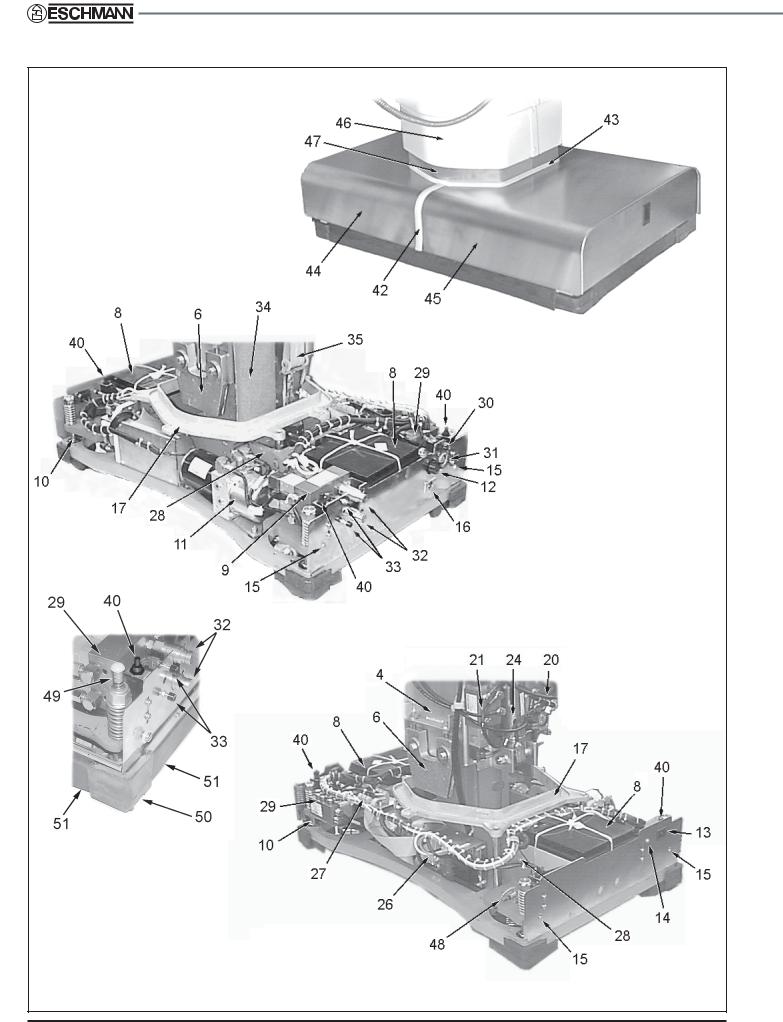Eschmann RX-500 Service manual

RX500
OPERATION TABLE
ManualService
698265 |
T-SM13h |

Preliminary Information 
Technical Data 
Safety Notes 
Introduction 
Description 
Maintenance 
Eschmann After Sales Service Department
The Eschmann After Sales Service Department is staffed and equipped to provide advice and assistance during normal office hours.To avoid delays when making enquires, please quote the Model and Serial Number of your Operation Table which is shown on the Serial Number plate, the location of which is shown below. Please ensure you include all alpha and numeric digits of the Serial Number.
The Serial Number Plate is on the inside of the long trunk section here.
ServiceManual
For further information visit www.eschmann.co.uk
All correspondence relating to the after sales service of Eschmann Equipment to be addressed to :
UK Customers
Eschmann Equipment, Peter Road, Lancing, West Sussex BN15 8TJ, England. Tel: +44 (0) 1903 765040. Fax: +44 (0) 1903 762006.
Overseas Customers
Contact your local distributor. In case of doubt contact Eschmann Equipment.
Patents and Trade marks
The ESCHMANN name and logo are registered trade marks of Eschmann Holdings Limited. “Eschmann Equipment” is a trading name ofEschmann Holdings Limited.
“RX600” is a adetr mark of Eschmann Holdings Limited.
Patents: |
GB 2260075 & GB 2242624; France 536922 & 450836; US5116032; |
|
Germany P69206378.1 & P69104883.5; Italy 536922 & 450836. |
|
Patents pending in Japan, application numbers 263630/92 & 97990/91. |
Copyright © 2002
All rights reserved.This booklet is protected by copyright. No part of it may be reproduced, stored in a retrieval system or transmitted in any form or by any means, electronic, mechanical, photocopying, recording or otherwise without written permission from Eschmann Holdings Limited.
The information in this publication was correct at the time of going to print.The Company, however, reserves the right to modify or improve the equipment referred to.
If the CE mark is affixed to the product, it indicates compliance with Council Directive 93/42/EEC of 14 June 1993 concerning medical devices.
T-SM13h October 2002

RX500
OPERATION TABLE
READ THESE INSTRUCTIONS BEFORE USE
Keep these Instructions in a safe convenient place for future reference. Read in conjunction with the relevant Publications detailed in the preliminary information section.
CONTENTS
Section |
Contents |
Page |
Section |
Contents |
|
Page |
||
1. |
PRELIMINARY INFORMATION ..................... |
4 |
|
Remove Long & Short Trunk Assemblies . 23 |
||||
2. |
TECHNICAL DATA .......................................... |
4 |
|
Install Long & Short Trunk Assemblies . 23 |
||||
3. |
SAFETY NOTES ............................................ |
5 |
|
Remove Break Cylinder ........................ |
|
26 |
||
4. |
INTRODUCTION ............................................ |
6 |
|
Install Break Cylinder ............................ |
|
26 |
||
|
General ....................................................... |
|
7 |
|
Remove Lateral Tilt Cylinder ................. |
|
27 |
|
|
Electrical System ........................................ |
7 |
|
Install Lateral Tilt Cylinder.. ................... 27 |
||||
|
Main Control Board ................................. |
7 |
|
Remove Trendelenburg Cylinder ........... |
|
27 |
||
|
Height Opto Board .................................. |
7 |
|
Install Trendelenburg Cylinder ............... |
|
28 |
||
|
Tilt Opto Board ........................................ |
7 |
|
Remove Height Cylinder ....................... |
|
28 |
||
|
Base Distribution Board .......................... |
8 |
|
Install Height Cylinder ........................... |
|
28 |
||
|
Top-Of-Column Distribution Board .......... |
8 |
|
Gas Spring Replacement ...................... |
|
29 |
||
|
Top-Of-Column Solenoids Board ............ |
8 |
|
Remove Batteries .................................. |
|
29 |
||
|
Power Circuits ......................................... |
8 |
|
Install Batteries ..................................... |
|
29 |
||
|
Hand Control ........................................... |
8 |
|
Remove the Base Feet ......................... |
|
29 |
||
|
Footswitch ............................................... |
|
8 |
|
Install the Base Feet ............................. |
|
30 |
|
|
Table-Base ON/OFF Control ................... |
8 |
|
Infillinterlockingmechanismreplacement .............. |
|
30 |
||
|
Built-in Battery Charger ........................... |
9 |
|
Pushbuttonreplacementandadjustment .............. |
|
30 |
||
|
External Battery Charger ........................ |
9 |
|
Remove/Install Hydraulic Components |
.. 30 |
|||
|
Standby System Connections ................. |
9 |
|
Remove/Install Electrical Components |
... 30 |
|||
5. |
DESCRIPTION ............................................. |
|
10 |
|
Fault Diagnosis ......................................... |
|
31 |
|
6. |
MAINTENANCE ........................................... |
14 |
|
Table 1: Fault Diagnosis ........................ |
|
31 |
||
|
General ..................................................... |
|
14 |
|
Circuit Diagram Index ............................ |
|
30 |
|
|
Cleaning and Storage ............................... |
14 |
|
Table 2: Codes for 2-Digit Display ......... |
|
34 |
||
|
General Care and Lubrication ................... |
14 |
FIGURES |
|
|
|
||
|
Gas Springs .......................................... |
14 |
1 |
RX500 Operation Table .................................. |
|
6 |
||
|
Head, Leg, & Infill Sections ................... |
14 |
2 |
RX500 Operation Table: Base Details .......... |
|
10 |
||
|
Head, Leg, & Infill-Locking Mech. ......... |
14 |
3 |
RX500 Operation Table: Column/Trunk Detail 12 |
||||
|
Long and Short Trunk Sections ............. |
14 |
4 |
RX500 OperationTable:Base (short trunk end) |
.... |
13 |
||
|
Radiographic Tops ................................. |
14 |
5 |
RX500 OperationTable:Base (long trunk end) ..... |
|
13 |
||
|
Underside of the Table Base ................. |
14 |
6 |
Table Tilted for Access .................................. |
|
15 |
||
|
Access to Fuses .................................... |
15 |
7 |
Base Detail Table Tilted ................................ |
|
15 |
||
|
Hand control .......................................... |
15 |
8 |
Main Control Board....................................... |
|
15 |
||
|
After Maintenance ................................. |
15 |
9 |
Hydraulic System - Schematic Diagram ....... |
|
16 |
||
|
Functional Checks .................................... |
15 |
10 |
Hydraulic System - Main Components ......... |
|
17 |
||
|
General ................................................. |
|
15 |
11 |
Trendelenburg Microswitch ........................... |
|
19 |
|
|
Hydraulic System ...................................... |
18 |
12 |
Lateral Tilt Opto |
............................................ |
|
19 |
|
|
General ................................................. |
|
18 |
13 |
Break Microswitch ........................................ |
|
19 |
|
|
Topping-Up Reservoir ........................... |
18 |
14 |
Tilt Switch ..................................................... |
|
|
20 |
|
|
Adjustments .............................................. |
|
18 |
15 |
Cover Retaining Push Rivets ........................ |
|
21 |
|
|
Trendelenburg Microswitch ................... |
18 |
16 |
Top of Column Hinge Assembly Detail ......... |
|
22 |
||
|
Lateral Tilt Opto ..................................... |
18 |
17 |
Top of Trendelenburg Cylinder ...................... |
|
23 |
||
|
Break Microswitch ................................. |
19 |
18 |
Break Cylinders |
............................................ |
|
24 |
|
|
Tilt Switch .............................................. |
|
20 |
19 |
Lateral Tilt Cylinder ....................................... |
|
25 |
|
|
Removal and Installation ........................... |
20 |
20 |
Trendelenburg Cylinder ................................ |
|
27 |
||
|
General ................................................. |
|
20 |
21 |
Top of Column Detail .................................... |
|
28 |
|
|
Remove Table Base Covers .................. |
20 |
22 |
Bottom of Height Cylinder Detail .................. |
|
28 |
||
|
Install Table End Base Covers .............. |
20 |
23 |
Gas Spring Detail ......................................... |
|
29 |
||
|
Remove Top-Of-Column Covers ........... |
21 |
24 |
Base Feet Detail ........................................... |
|
29 |
||
|
Install Top-Of-Column Covers ............... |
21 |
25 |
Infill interlocking mechanism......................... |
|
30 |
||
|
Releasing Telescopic Cover & Upstand 21 |
26 |
Catch mechanism ......................................... |
|
30 |
|||
|
Refixing Telescopic Cover & Upstand ... |
21 |
27 |
Hand Control Functions ................................ |
|
34 |
||
|
Removing the Telescopic Cover ............ |
21 |
28-35Circuit Diagrams* ................................. |
35-40 |
||||
|
Replacing the Telescopic Cover ............ |
21 |
|
(* also see Circuit Diagram Index on page 33) |
||||
|
|
|
|
|
|
|
|
|
T-SM13h |
3/40 |

1.PRELIMINARY INFORMATION
1.1This Service Manual should be referred to for details of the RX500 Powered Operation Table, REF 80-600-29 (series) and REF 80-600-61 (series) having Serial Number R5BC8J0000 or above.
Related Technical Publications, available on request from Eschmann Equipment :-
Instructions for Use - T-IM28 - RX500 Powered Operation Table
Illustrated Parts List - T-IPL11- RX500 Powered Operation Table
1.2Instruction and Service Manuals should be readily accessible for reference prior to and when operating, cleaning and servicing the Operation Table.
2. TECHNICAL DATA
DIMENSION
Table with standard table-top |
(Fig. 1) : |
|
Width including sidebars ............................. |
|
560mm |
Sidebars ...................................... |
(31.75 x 6.35)mm |
|
Overall length (with infill section) |
............... |
2000mm |
Minimum table height (without mattresses) ....... |
700mm |
|
Maximum table height (without mattresses) .... |
1040mm |
|
SAFETY
The table is built to comply with BS5724 Part 1, BS5724 Part 2 Section 2.22, IEC601-1, IEC601-1-2:1993 and BS6859 Part 1.The mattresses comply with BS2891.
TABLE LOADING
The standard table (Fig. 1) satisfies a static load test in accordance with the requirements of BS5724
MOVEMENTS
Maximum Trendelenburg .................................... |
35° |
Maximum Reverse Trendelenburg...................... |
35° |
Maximum Lateral Tilt (left and right)................... |
15° |
Maximum Extension ......................................... |
220° |
Maximum Flexion ............................................. |
130° |
Head section adjustment ................................ |
±45° |
Leg section adjustment ......................... |
(-100+10)° |
Note: With the table at minimum height, maximum Trendelenburg, and maximum head and leg section movements are reduced due to physical restrictions (i.e. proximity of floor)..
WEIGHT (nominal)
Table with standard table-top (Fig. 1) ............ |
300kg |
SYMBOLS & SAFETY CLASSIFICATIONS
Caution Refer to the accompanying documents, the “Instructions for Use”.
or IPX 4 indicates that the equipment will withstand a moderate quantity of fluid spilled from above.
Safety Category
Indicates that the equipment is in safety category BF, i.e. it is manufactured to a safety standard which agrees with
international regulations for medical electrical equipment, and provides a high degree of protection against electric shock.The symbol also indicates that the equipment will not be damaged by defibrillator discharge.
Indicates that the equipment is in safety category B, i.e. it is manufactured to a safety standard which agrees with international regulations for medical electrical equipment, and provides a minimum degree of protection against electric shock.
Class 2 Indicates that the built-in battery charger is designed to electrical protection Class 2.
Anaesthetic Proof
Indicates that the parts of the equipment marked AP are designed for use within a distance of (5 to 25cm) of a part of an enclosed medical gas system. BS5724 Part 1, 1989 refers.
Indicates that the parts of the equipment marked APG are designed for use within a distance of 5cm of a part of an enclosed medical gas system. BS5724 Part 1,1989 refers.
WARNING
The head section of this operation table is classified as ‘EQUIPMENT not suitable for use in the presence of a flammable anaesthetic mixture with air or with Oxygen or Nitrous Oxide’ and is NOT classified as ‘Category AP Equipment’ or ‘Category APG Equipment’ when it (the head section) is in its lowest position and the table top is in full Trendelenburg position.
Inspection
The table must be inspected at regular intervals, and if necessary, serviced, to ensure that it complies with all AP and APG requirements relevant to physical deterioration or breakage of electrical components, connections and cable insulation.
4/40 |
T-SM13h |

RX500
OPERATION TABLE
2. TECHNICAL DATA
MISCELLANEOUS
Antistatic requirements
The table has an antistatic pathway from the tabletop, through an internal resistor to the castors, which are held in contact with the floor at all times.
CAUTION
1.To complete the antistatic pathway, the table must be used on an electrically conductive, or on an antistatic floor.
2.Always use purpose-designed Eschmann mattresses to maintain the antistatic pathway.
Electrical data |
|
System Power |
|
Batteries: |
|
Type ....................................... |
Two sealed lead-acid |
Output (each) ......................................... |
12V 24Ah |
Built-In Battery Charger: |
|
Input ...................................... |
200-240Vac 50/60Hz |
Output .............................. |
27.6Vdc (nom) 3A (max) |
System Fuses: |
|
|
|
Motor ....................................... |
30A 1.5in. (AGU 30) |
||
Base Control Board: (1) ........ |
F6.3A 250V |
20mm |
|
(1) ........ |
T2.5A |
250V |
20mm |
(1) ........... |
T2A |
250V |
20mm |
CAUTION
This equipment contains environmentally hazardous lead-acid batteries. If the batteries fail, or if the equipment is to be disposed of, it is recommended that the batteries are taken to a disposal site designated for the disposal of leadacid batteries, or that the batteries are collected by an agent who specialises in the collection of lead-acid batteries.
Hydraulic Oil
Type ..................... |
Eschmann RX (Part No. 699408) |
3. SAFETY NOTES
Attention to the following points will prolong the life and efficiency of the RX500 Powered Operation Table and will help to avoid the risk of accidents, or damage.
DO:
♦Keep the Instruction Manual close-to-hand.
♦Read the instructions carefully before using table.
♦Check that the head and leg sections are secure, and put the table base in the braked position before use.
♦Disconnect the built-in battery charger from the power supply and switch table off before washing.
♦Read and follow the instructions for cleaning, and for the care of the mattresses.
♦Use the correct mattresses and accessories.
♦Remove table accessories and their clamps (in particular rotary clamps) from sidebars, when they are not being used.
♦Ensure that the table is serviced at regular intervals (every 6 months is the recommended frequency) by Eschmann personnel only, or accredited agents.
DO NOT:
♦Lift the table by its table-top.
♦Push the table over rough surfaces, use a trolley.
♦Drop the table (or individual sections).
♦Put heavy weights on the table sections.
♦Put sharp objects on, or against, mattresses, pads, or the radiographic table-tops.
♦Drop heavy objects onto the radiographic table-tops.
♦Spill oil, ether, or other fluids onto the mattresses or the pads.
♦Pull the table by any of the table-top sections,
always push it.
♦Hold or support the leg section by its black
radiographic top, as this is a removable item and might come off.
Note: The table cannot be used (under normal circumstances) with table base standby door open.
WARNING
The RX500 Powered Operation Table has been designed to minimise the possibility of accidental electrosurgery burns. Contact with any metal surfaces (e.g. table side bars, or other equipment etc.) can cause burns during electrosurgery and must be avoided.
With the table in (or during transition into) the castor position, the centre of gravity of the patient (normally the perineum) should lie no more than 200mm away from the centre of the column (i.e. no more than the length of the short trunk section). Whenever this is not practical the overhanging weight of the patient and table should be adequately supported (e.g. by at least two able people). Also see Warnings in Instruction for Use and within the text of this publication.
T-SM13h |
5/40 |

4. INTRODUCTION
|
|
|
|
View on ‘A’ |
1. |
Head section |
17. |
Hand control plug |
|
2. |
Infill section |
18. |
Table |
(on/off) switch |
3. |
Short trunk section |
19. |
Push button switches to engage standby |
|
4. |
Long trunk section |
|
hydraulic connectors |
|
5 |
Leg section |
20. |
Standby hydraulic connectors |
|
6. |
Release bar |
21. |
Quick-charge external battery charge socket |
|
7. |
Gas springs |
22. |
High current 30A fuse |
|
8. |
Release button (leg section removal) |
23. |
Standby door microswitch |
|
9. |
Release button (Infill section removal) |
24. |
Standby power pack connector |
|
10. |
Hand control |
25. |
Standby door |
|
11. |
Release button (head section removal) |
26. |
Built-in battery charger socket |
|
12. |
Release bar |
27. |
Battery charger ‘on’ indicator (green) |
|
13. |
Telescopic column |
28. |
Battery charger door |
|
14. |
Table base |
29. |
Removable mains lead |
|
15. |
Hand control or footswitch socket |
30. |
Cover retaining screws |
|
16. |
Hand control or footswitch socket |
31. |
Top of column covers |
|
|
View on base short trunk end |
View on base long trunk end |
||
Fig. 1 RX500 Powered Operation Table
6/40 |
T-SM13h |

RX500
OPERATION TABLE
4. INTRODUCTION
GENERAL
4.1This Service Manual contains a technical description and maintenance procedures for the RX500 Powered Operation Table.
4.2The RX500 Powered Operation Table is a fully mobile table with a five section top comprising short and long trunk sections, an interchangeable infill section and head and leg sections.
4.3The table enables a full range of surgical and radiographic procedures to be done including: general, urological, gynaecological, cardiothoracic, ophthalmic, ENT and neurosurgical. Certain procedures require the addition of specific accessories, information about which is available on request.
4.4The RX500 Powered Operation Table is an electro-hydraulically operated, battery powered unit, remotely operated from a touch-button hand control, or a footswitch, both plug into the top of the table column
4.5Power is provided by two 12V sealed lead-acid batteries in the table base. The 12V batteries are connected in series to give an output voltage of 24V. Trickle charging for the batteries is provided by an inbuilt battery charger, provision is also made for connection of an external battery charger for quick battery charging.
4.6All table top trunk movements are electrically controlled using either the hand control or, as an optional accessory the four function footswitch (height and Trendelenburg only) which is used by the surgeon during certain procedures.
4.7The operation table has these main sections: G Base.
G Central column. G Long trunk.
G Short trunk.
G Interchangeable head, leg and infill sections.
NOTE: Instruction and Service manuals should be readily accessible for reference prior to, and when operating, cleaning, and servicing the table.
ELECTRICAL SYSTEM
NOTE: Electrical/electronic circuit diagrams are provided at the end of this Manual in section 6 (see index page 33).
Main Control Board
4.8 The main control board receives signals from the hand control via an RS485 serial communication link. The board also receives signals from the footswitch, base cover switches, levelling microswitches, tilt switch, opto boards, standby unit socket, door switch and table on/off controls.
4.9Outputs from the main control board pass to the hand control via an RS485 serial communication link, to the hydraulic solenoids via the top-of-column distribution and solenoid boards, and to the base distribution board, motor on/off control and motor direction control. The main control board is supplied with 24V d.c. from the batteries and generates its own 12V d.c. and 5V d.c. supplies.
4.10The principal functional areas of the main control board are:
-Input buffering (pull-up and pull-down resistors and capacitors).
-The microcontroller, which uses software to implement table control functions.
-Output buffering (current drivers and level shifters).
-Motor direction drive and on/off control.
Height Opto Board
4.11The height opto board is fitted at the base of the column in a fixed position relative to the baseplate. It responds to a metal reflector plate which moves up and down with the column chassis and hence with the table top. When the reflector moves in front of the three reflective opto sensors (only two are used) electrical signals are generated to signal to the main control board that the table is at or above ‘minimum height’, or in the ‘castor’ position.
4.12When the reflector plate is in front of reflective opto coupler 01 and at the correct distance from it, a signal is produced which passes via J1 on the opto board and the 10-way ribbon cable to J22 on the main control board.
4.13When the reflector plate is in front of both reflective opto couplers 01 and 03 signals from both pass to the main control board which stops the table movement at the correct position.
Tilt Opto Board
4.14The tilt opto board is fitted at the top of the column in a fixed position relative to the yoke.It responds to a metal plate which moves with the yoke and hence with the table top. When the reflector moves in front of the opto sensors electrical signals are generated to signal the main control board that the table is level.
4.15When the reflector plate moves in front of the opto sensor, a logic signal 0 is produced which passes via J1 on the opto board to the top of column distribution board and then via a 10-way ribbon cable to J2-4 on the main control board.
4.16When the reflector plate is not in front of the opto sensor, a logic signal 1 is produced which is passed to the main control board as above.
T-SM13h |
7/40 |

4. INTRODUCTION
Base Distribution Board
4.17This board receives signals from the main control board for the height (extend) solenoid, the height (contract) solenoid, the pump-isolate (forward) solenoid and the pump-isolate (reverse) solenoid.
4.18The board also passes signals to the main control board from the cover microswitches .
4.19Any inductive overswings from the solenoids are blocked by diodes Dl to D4. PL7 on the base distribution board is connected via a 14-way ribbon cable to J4 on the main control board.
Top-of-Column Distribution Board
4.20 This board connects to J2 on the main control board via a 34-way retractable ribbon cable which terminates on PL1 of this board. It distributes signals to 10-way hand control/footswitch sockets PL2 and PL3, and to:
Gthe tilt switch via PL7
Gthe Trendelenburg level position microswitch via PL5
Gthe lateral tilt opto board via PL4
Gthe break level position microswitch via PL6
Gtop-of-column solenoids board via PL8
Gtable ON/OFF switch via PL9
Top-of-Column Solenoids Board
4.21 This board receives signals on J7 via a 10way ribbon cable from J8 on the top-of-column distribution board to drive the top-of-column solenoids via cage clamp connectors J1 to J6. It also blocks inductive overswings from solenoids using diodes D1 to D6.
Power Circuits
4.22The power source for the table are two 12V, 24Ah sealed lead acid batteries connected in series. A 30A in-line, high current fuse protects the batteries, motor, FET’s, relay and interconnections. The fuse is fitted on a panel in the table base.
4.23Current from the batteries passes via the reversing relay, where it is switched by the FET’s, and then passes to the pump motor and returns to the batteries. The 24V d.c. supply is also routed to the hydraulic solenoids and the main control board.
Hand control
4.24The RX500 hand control communicates with the main control board via an RS485 serial communication link. The hand control contains a microcontroller which receives inputs from the hand control buttons and generates outputs which go to the hand control LED’s and the hand control audible warning device.The microcontroller uses software to implement hand control, control functions.
4.25The hand-control incorporates a 2-digit display that indicates a code if a problem should occur. Such problems could be the result of the user pushing a button in the wrong sequence or at the wrong time or of a system failure (see Table 1 - Fault Diagnosis, Table 2 - Codes for 2-Digit display and Fig. 27)
Footswitch (Optional Accessory)
4.26The footswitch plugs into either of the two 10way sockets used by the hand control. It uses the same +5V d.c. and 0V pins, but the signal lines are different from those of the hand control.The footswitch does not use a serial communication link.
4.27There are four functions on the footswitch:
G Height up G Height down
G Trendelenburg
G Reverse Trendelenburg.
4.28Each of these four functions is associated with two microswitches mounted inside the body of the footswitch, one normally open and the other normally closed. The normally open microswitch for each function is connected on one side to the +5V d.c. line and on the other side to a common ‘alarm’ line. The normally closed microswitch for each function is connected on one side to the 0V line and on the other side to an individual input line on the main control board. If, for any function of the footswitch, e.g. height up, the normally open microswitch operates and the normally closed microswitch does not, or vice versa, the main control board will recognise a fault and freeze the table. The likelihood of two microswitches failing at the same time is very remote.
Table Base ON/OFF Control
4.29 An ‘on/off’ toggle switch, fitted on the top of the table column, switches 24V d.c. on the main control board. To isolate the system the 30Amp fuse should be removed.
8/40 |
T-SM13h |

RX500
OPERATION TABLE
4. INTRODUCTION
Built-in Battery Charger
4.30This is a low current output ‘trickle’ charger which replenishes an average day’s table use of the batteries with an overnight charge.
4.31The mains input comes via the mains lead, which should be fitted with a fused plug. The output of the charger is regulated to provide 27.6V d.c. to the batteries for float charging. This voltage will fall when the batteries are not completely charged and hence are drawing a significant current. The charger has short-circuit and thermal protection. There is an output from the board which supplies current to the batteries, an output to the ‘trickle’ charger indicator LED and an input from the external charger. Current from either the internal or the external charger is routed to the batteries via the ‘trickle’ charger board.
External Battery Charger (Optional Accessory)
4.32 The external battery charger plugs into the external battery charger socket in the table base and supplies current via the ‘trickle’ charger board to the batteries.
Standby System Connections
4.33An RX Standby Unit (optional accessory) which provides standby hydraulic and electrical services, can be connected to the RX500 table via hydraulic connectors and an electrical socket behind the door on the table base (short trunk section end).
4.34Next to the hydraulic connectors are two pushbuttons which release stored hydraulic pressure when the standby hydraulic connections are made. This is done by energizing the pump forward and reverse solenoids with power from the standby unit.
4.35To connect the standby unit to the table it is necessary to open the base door. This operates a microswitch which disconnects the main control board solenoid control circuits from the solenoids so that they can be controlled by the standby unit, also the pump motor is hydraulically isolated from the hydraulic solenoids. The electrical signals from the standby socket pass to J1 on the main control board (15-way D-connector).
T-SM13h |
9/40 |

5. DESCRIPTION
For greater detail of the table base ends also refer to Fig. 4 and 5
Fig. 2 RX500 Operation Table : Base details, covers on and off
10/40 |
T-SM13h |

RX500
OPERATION TABLE
5. DESCRIPTION
Key to Figs 2 and 3
1.Short trunk assembly
2.Long trunk assembly
3.Lateral tilt cylinder
4.Wrap around
5.Trunk assembly plastic covers
6.Wedge
7.Outer column
8.Battery
9.Manifold block No 1
10.Castor plate guide pillar
11.Hydraulic power unit
12.High current fuse, 30A
13.Mains socket
14.Battery charging LED (green)
15.Cover retaining screw location
16.External battery charger socket
17.Drip gutter
18.Opto reflector plate
19.Inner column
20.Manifold block No 4
21.Manifold block No 3
22.Upper bezel
23.Cable from hand control
24.Trendelenburg cylinder
25.Break cylinders
26.Main control PCB
27.Base distribution PCB
28.Castor frame assembly
29.Manifold block No 2
30.Door microswitch
31.Standby power pack connector
32.Standby hydraulic connectors
33.Push buttons to engage standby hydraulic connectors
34.Hydraulic reservoir
35.Ribbon cable reel assembly
36.Top-of-column distribution PCB
37.Hinge
38.Lateral tilt opto board
39.Yoke
40.Cover microswitch
41.Table ‘on/off’ switch
42 Base seal
43.Column seal
44.Long trunk base cover
45.Short trunk base cover
46.Telescopic column cover
47.Column upstand
48.Antistatic discharge path resistor
49.Base cover spring support
50.Base foot
51.Base skirt
T-SM13h |
11/40 |

5. DESCRIPTION
Fig. 3 RX500 Operation Table : Column and trunk section detail
12/40 |
T-SM13h |
